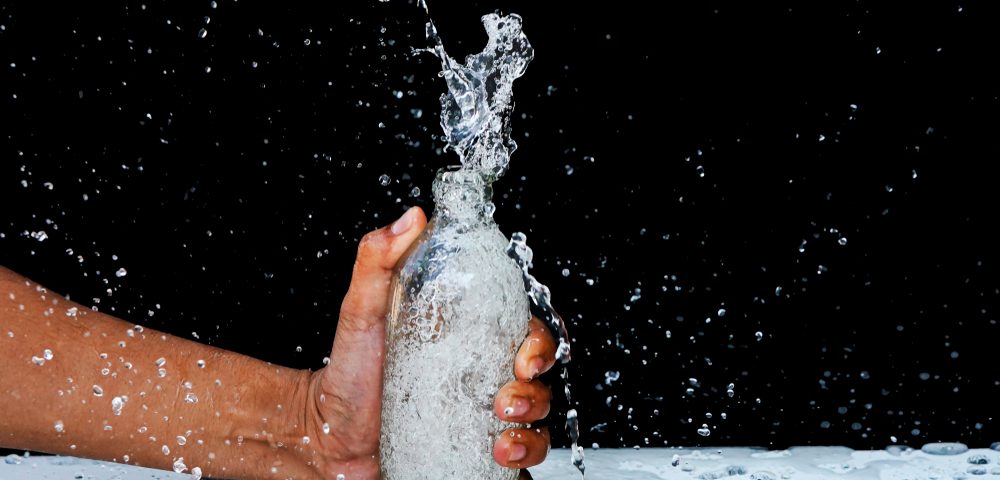I’ve never been one of those women with a water bottle in her hand or her purse wherever she goes. Knowing that drinking lots of water prevents wrinkles, I’d always assumed those ladies were concerned about the appearance of their skin. And because I’m more lazy than vain, the effort didn’t seem worth it to me.
Arthritis in my neck and shoulders was another factor that prevented carrying water. Anything heavy around my neck quickly becomes painful for me. I’ve used backpack-style purses long before they were fashionable. This way, the weight I carried distributed evenly between my shoulders.
A YouTube video I recently watched about dehydration may have changed my thinking. I was stunned to find many of my most common symptoms listed as being the result of too little water. I felt a momentary rush of excitement. What if drinking more water was the answer to all my health issues? Perhaps I could feel well and live a normal life!
Because I’m aware that not everything found on the internet is scientific fact, I decided to do more research. Sure enough, according to reputable sources such as the Mayo Clinic, the Cleveland Clinic, and the Centers for Disease Control and Prevention, fatigue, dizziness, confusion, muscle cramping, and mood changes were all listed as signs of dehydration. I became more interested. These are my most bothersome symptoms!
Fatigue is a very big issue for me. Most of my days begin with waking up tired. Even on the precious occasions when I have some energy early in the day, I begin to crash around 2 p.m., and by 4 p.m., I’m often asleep. If more water could give me more productive hours, I’d be grateful.
Confusion is another of my common complaints. I think of it as “fibro fog,” but I could also describe the feeling as confused, fuzzy-headed, bewildered, or any number of other things. Most of my life (including writing this column) would be easier with clearer thinking.
According to the CDC, inadequate water intake also causes mood changes. Because of my constant battle with bouts of depression and anxiety that don’t respond to much else, that potential complication definitely piqued my interest. Carrying water was looking better and better. And if there was anything at all that could diminish the pain I regularly endured from muscle spasms, I would try it — no matter what I had to carry.
The question then became: How much water should I be drinking? Each website I visited recommended a different amount. More than one suggested converting your weight to ounces and drinking half that amount. For me, that would be 72 ounces. That was roughly two glasses more than I normally drink, but it didn’t seem unreasonable to me.
A report by the Food and Nutrition Board stated that most people met their daily water requirement by letting thirst be their guide. Unfortunately, older adults (like me) often don’t feel thirsty until they’re already dehydrated. They recommended 91 ounces of water a day for women and 125 ounces for men. Then, they clarified that this amount could come from various sources of food and beverage in addition to the water we drink each day.
Adding in the liquid content of the fruits and vegetables I consume, and subtracting the dehydrating fluids that I drink (like tea and wine), I decided to focus on the 72-ounce goal. Yes, I’m about to become one of those bottle carrying women — but with a twist.
At a sporting goods store, I found myself a belt for hikers that holds a water bottle. It may not be fashionable, but it won’t aggravate my neck. And with any luck, one or more of my fibromyalgia symptoms will improve.
***
Note: Fibromyalgia News Today is strictly a news and information website about the disease. It does not provide medical advice, diagnosis, or treatment. This content is not intended to be a substitute for professional medical advice, diagnosis, or treatment. Always seek the advice of your physician or other qualified health provider with any questions you may have regarding a medical condition. Never disregard professional medical advice or delay in seeking it because of something you have read on this website. The opinions expressed in this column are not those of Fibromyalgia News Today, or its parent company, BioNews Services, and are intended to spark discussion about issues pertaining to fibromyalgia.



Thank you for the information, Christine.
I’d be really interested to read an update about any significant benefits you notice by increasing your fluid intake.
I haven’t seen any improvement but maybe I’d feel worse if I decreased my fluid intake. Hope you feel better on it.CynthiaCynthia.
Hope this helps relieve some of your symptoms. I am one of those women who always carry water with them. I actually carry a 52 oz bubba keg filled with ice water every day. Yes, it’s a hassle. But it’s worth it. I need to drink a lot of water everyday else, it’s a struggle for me to urinate (another FM symptom). It also helps with my fatigue (kind of), muscle cramps and I don’t get headaches all the time. I think especially those with FM they can have difficulty telling when they’re thirsty, not only because of the various medications but because we’re so distracted by our other symptoms and pain. I like the idea of the water belt!
Christine, have you found out if this has helped you yet? I didn’t drink hardly any water and during my drive home from work at 5 pm I began feeling desperately depressed, moody, and just plain sick. I notice today when I drink the water I start to feel better almost immediately, but it has to be ice cold water. Not sure what this is about.
I can’t be absolutely certain because I’ve had other issues appear since this time. However, I still focus on drinking as much as I can, and I really double up if my mouth feels dry. I guess only time will tell.